On the morning of Nov. 5, the ceremony on conferring Dr. Harold Kroto Honorable Professorship was held at the AHUT conference center. The University top including President Li Jiaxin, VP Wei Xianwen and VP Gu Mingyan attended the ceremony.
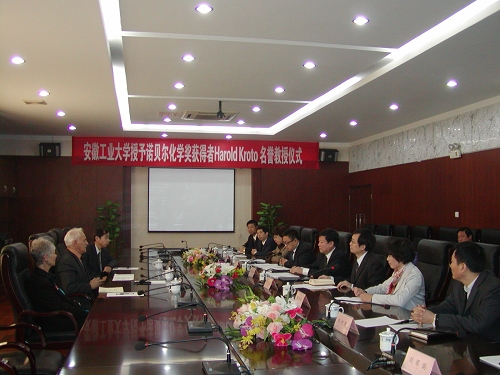
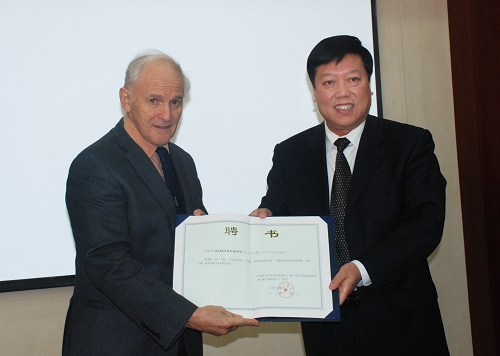
President Li expressed the warmest welcome to Prefessor Kroto and Mrs. Kroto on behalf of the university and made a brief introduction to the university’s history and development. Professor appreciated the great hospitality and related arrangements made for his and his wife’s visit and expressed his interest in communicating with AHUT staff and students for academic and cultural exchange purposes.
After the conversation, President Li conferred the honorable professorship on Dr. Harold Kroto.
On the afternoon of Nov. 5, Professor Kroto delivered a report named Carbon in Nano and Outer Space,which was hosted by VP Wei Xianwen. For the beginning, VP Wei introduced Professor Kroto’s background information, research field and his great scientific research achievements. When Professor Kroto communicated with the students, he pointed out that the university is the place for stuents to discover their potential. He mentioned that if anyone wants to know another nation’s culture, he has to study the nation’s language first and if anyone wants to know nature and science, he has to master the mathematics first. Professor Kroto also mentioned his personal experience to discover the C60 and its future potential application in nano-science and technology. In addition, Professor introduced his work to launch the Vega Science Trust (www.vega.org.uk) to create science films of sufficiently high quality for broadcast on UK network television and he is now heavily involved with GEOSET a Global Educational Outreach for Science, Engineering, and Technology programme (www.geoset.info and www.geoset.fsu.edu) which he initiated after moving to Florida State University. GEOSET seeks to exploit the revolutionary creative dynamics the Internet (which Harry calls it the GooYouWiki-World) to improve the general level of science understanding and awareness worldwide. Numerous universities in the US, UK, Japan, Croatia and Spain are now contributing to GEOSET’s rapidly growing, globally accessible freely available cache of science educational material in modular form designed to help teachers. A most exciting aspect of this initiative has been the revelation that graduate and undergraduate students are often exceptionally good at creating educational modules. Professor Kroto also expressed his support for AHUT to be the first university in China to join in the GEOSET program.
In the end, Professor Kroto encouraged students to do what they are interested in. He mentioned that if he had just aimed to win the Nobel Prize for his scientific research, he maybe would have never got the chance to win the prize and the prize was only an exceptional award to his research because he occasionally discovered C60. 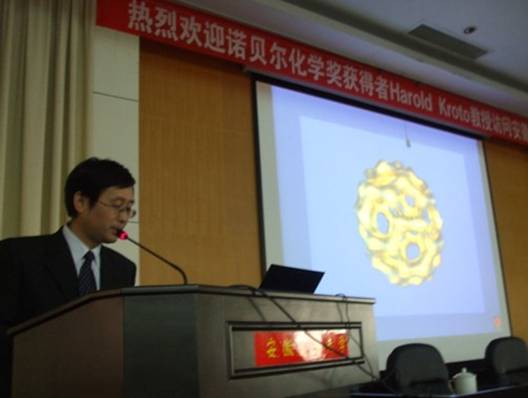
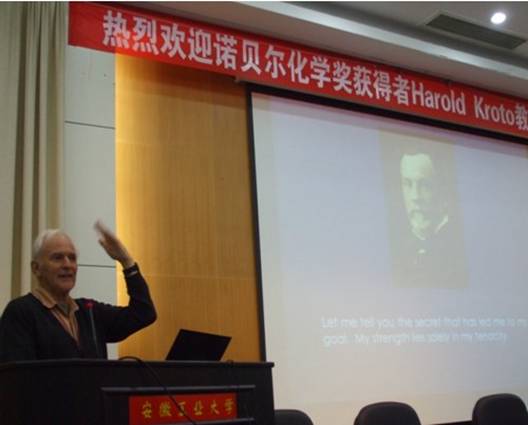
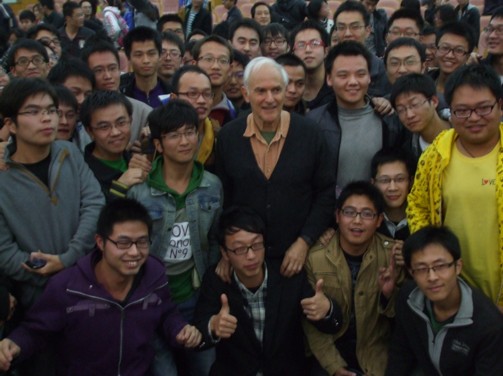
On Nov. 6, Professor Kroto and Mrs. Kroto toured around the campus and visited some labs, the library on the east campus and school industries including Huaqi Environmental Protection Company and Giant Hydraulic Breaker Company and communicated with the companies’ staff. Furthermore, Professor Kroto joined in the discussion with some professors from the School of Chemical Engineering, AHUT, which was hosted by the dean Professor Cui Ping. He encouraged AHUT professors to be more engaged in the interdisciplinary research work.
Sir Harold (Harry) Kroto is currently a Francis Eppes professor of Chemistry at Florida State University, where he is carrying out research in nanoscience and cluster chemistry as well as developing exciting new Internet approaches to STEM educational outreach. In 1996 he was knighted for his contributions to chemistry and later that year was one of three recipients of the Nobel Prize for Chemistry in 1996. He is a Fellow of the Royal Society of London, and holds an emeritus professorship at the University of Sussex in Brighton, United Kingdom. The research program focuses on the complex range of molecular constituents in carbon vapour; the development of novel 2 and 3D metal-cluster/organic frameworks as well as peptides; the stabilization of small fullerenes; and carbon nanotube based devices behaviour.
Harry obtained a first class BSc honours degree in Chemistry (1961) and a PhD, in molecular spectroscopy in 1964 at the University of Sheffield (UK). After post-doctoral positions at the National Research Council in Ottawa, Canada (1964-66) and at the Murray Hill Bell Laboratories (NJ, US) in 1966-67 he started his independent academic career at the University of Sussex. In 1970 his research group conducted laboratory began spectroscopic studies on long linear carbon chain molecules with colleague David Walton. This research led to radio astronomy searches with Takeshi Oka and Canadian astronomers (Lorne Avery, Norman Broten and John McLeod) at the National Research Council in Canada which made the surprising discovery that they existed in unusually copious amounts in certain regions of interstellar space. At the same time he developed flash thermolytic synthetic methods to create new metastable species and intermediates with multiple bonds between carbon and second and third row atoms (S, Se and P) and applied microwave spectroscopic techniques to detect and characterise them. The work on multiply bond carbon-phosphorus species (with Sussex colleague John Nixon) created the first molecule with a C=P double bond and the second with a C≡P triple bonded species. The general synthetic techniques developed opened up the exciting new fields of Phosphaalkene and Phospahalkyne Chemistry. Conclusions derived from the earlier radioastronomy breakthrough on carbon species in space led to experiments in 1985 together with Robert Curl, Richard Smalley and research students Jim Heath, Sean O’Brien and Yuan Liu at Rice University (Texas). These laboratory experiments which simulated the chemical reactions in the atmospheres of red giant stars uncovered the existence C60 Buckminsterfullerene, the third well characterised form of carbon, for which he together with Curl and Smalley received the 1996 Nobel Prize in Chemistry.
He has numerous awards including the Copley Medal, Faraday Lectureship of the Royal Society as well as the Tilden Lectureship and Longstaff Medal of the Royal Society of Chemistry. Other awards include the Louis Vuitton – Moet Hennessy Science pour l’Art prize and the Italgas Prize for Innovation. He holds some 36 honorary degrees from universities all over the world and is a Freeman of the City of Torino. From 2004 he has been on the Board of Scientific Governors at Scripps Institute. He was elected a Foreign Associate of the National Academy of Sciences in 2007.